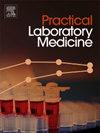Impact of blood centrifugation on the parameters of thrombin generation assay revisited to look for possible revision of the current guidance
IF 1.7
Q3 MEDICAL LABORATORY TECHNOLOGY
引用次数: 0
Abstract
Blood centrifugation affects thrombin generation assays (TGA). Current guidance recommends double-centrifugation, which is uncommon in clinical laboratories.
We evaluated the impact of 4 centrifugation speeds on TGA performed with low-triggers (1pM tissue-factor/1.0 μM phospholipids) or high-triggers (5pM tissue-factor/5.0 μM phospholipids). TGA parameters were evaluated in the presence/absence of thrombomodulin.
We included 20 healthy subjects. Centrifugation speeds were: (i)Double-centrifugation: blood at 2,500g(15min) and plasma at 2500(15min) (reference method). (ii)Single-centrifugation at 3,000g(20min). (iii)Single-centrifugation of blood at 3,000g(20min), plasma freezing, then centrifugation of thawed plasma at 10,000g(5min). (iv)Single-centrifugation at 1,700g(10min). Results were also expressed as percentage difference relative to reference centrifugation.
Lag-time was affected when centrifugation speed was relatively slow (1,700g), regardless of low- or high-triggers, presence or absence of thrombomodulin, whereas it was scarcely affected by centrifugation at 3,000g. Peak-thrombin was marginally affected at relatively low-speed (1,700g). ETP was marginally affected at relatively low-speed (1,700g), except when TGA was performed in the presence of thrombomodulin. Peak-thrombin and ETP were not or were poorly affected by centrifugation at 3,000g or 10,000g after thawing, respectively.
In conclusion, slow-centrifugation (1,700g) had a considerable impact on lag-time. This centrifugation speed represents common practice in clinical laboratories and should not be used for TGA, unless controls samples centrifuged at the same speed are used for comparison. Single-centrifugation at 3,000g may be a suitable alternative, which would allow TGA testing without the complex and time-consuming double-centrifugation as recommended by current guidance. We propose that current guidance on plasma preparation for TGA be switched from double-to a more intense single-centrifugation.
重新审视血液离心对凝血酶生成测定参数的影响,以寻找对当前指南的可能修订
血液离心影响凝血酶生成测定(TGA)。目前的指导建议双重离心,这在临床实验室中并不常见。我们评估了4种离心速度对低触发(1pM组织因子/1.0 μM磷脂)或高触发(5pM组织因子/5.0 μM磷脂)进行TGA的影响。在存在/不存在血栓调节素的情况下评估TGA参数。我们纳入了20名健康受试者。离心速度:(i)双离心:血液2500g (15min),血浆2500g (15min)(参考方法)。(ii) 3000g单次离心(20min)。(iii) 3000g血液单次离心(20min),血浆冷冻,再10000g解冻血浆离心(5min)。(iv) 1700 g单次离心(10min)。结果也表示为相对于参考离心的百分比差异。当离心速度相对较慢(1,700g)时,滞后时间受到影响,无论低触发还是高触发,存在或不存在血栓调节素,而在3,000g时,它几乎不受影响。峰值凝血酶在相对低速(1,700g)时受到轻微影响。在相对低速(1,700g)时,ETP受到轻微影响,除非在血栓调节素存在的情况下进行TGA。解冻后分别在3000g和10000g离心对凝血酶峰和ETP没有或影响很小。总之,慢速离心(1,700g)对滞后时间有相当大的影响。此离心速度代表临床实验室的常用做法,不应用于TGA,除非以相同速度离心的对照样品用于比较。3000g的单离心可能是一个合适的选择,这将允许TGA测试,而不需要当前指导建议的复杂和耗时的双离心。我们建议将目前TGA血浆制备的指导从双离心改为更强的单离心。
本文章由计算机程序翻译,如有差异,请以英文原文为准。
求助全文
约1分钟内获得全文
求助全文
来源期刊

Practical Laboratory Medicine
Health Professions-Radiological and Ultrasound Technology
CiteScore
3.50
自引率
0.00%
发文量
40
审稿时长
7 weeks
期刊介绍:
Practical Laboratory Medicine is a high-quality, peer-reviewed, international open-access journal publishing original research, new methods and critical evaluations, case reports and short papers in the fields of clinical chemistry and laboratory medicine. The objective of the journal is to provide practical information of immediate relevance to workers in clinical laboratories. The primary scope of the journal covers clinical chemistry, hematology, molecular biology and genetics relevant to laboratory medicine, microbiology, immunology, therapeutic drug monitoring and toxicology, laboratory management and informatics. We welcome papers which describe critical evaluations of biomarkers and their role in the diagnosis and treatment of clinically significant disease, validation of commercial and in-house IVD methods, method comparisons, interference reports, the development of new reagents and reference materials, reference range studies and regulatory compliance reports. Manuscripts describing the development of new methods applicable to laboratory medicine (including point-of-care testing) are particularly encouraged, even if preliminary or small scale.
 求助内容:
求助内容: 应助结果提醒方式:
应助结果提醒方式:


